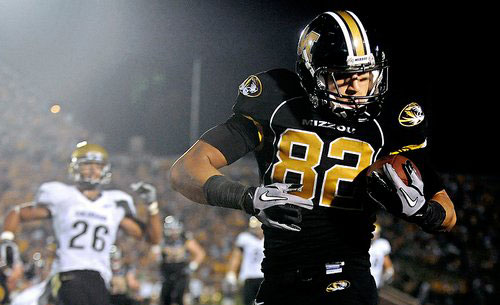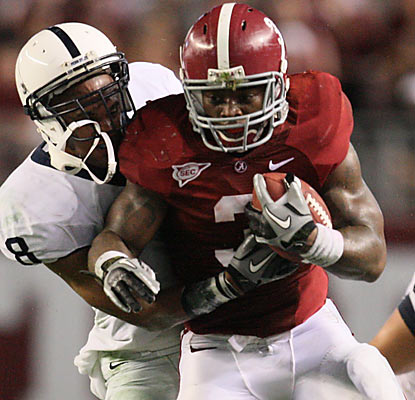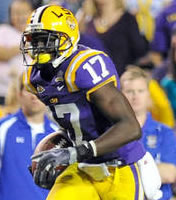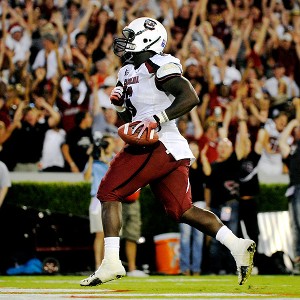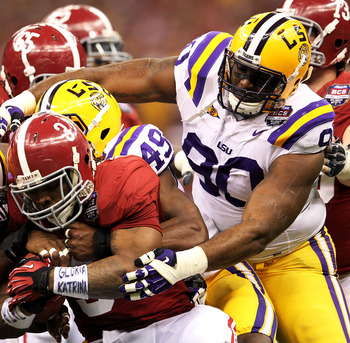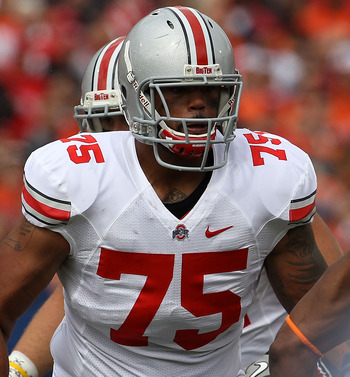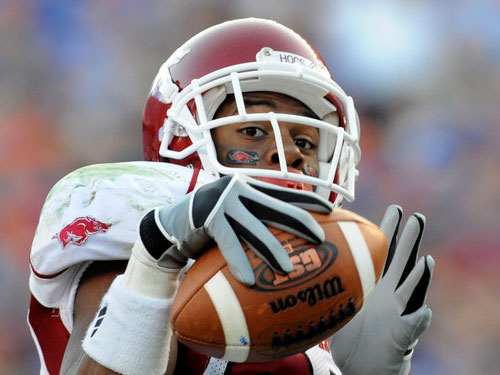Yesterday I was invited to take part in a collaborative mock draft alongside Dan Kadar of Mocking the Draft, Brad Clark of NFL’s Future and Jeff Risdon of Real GM. I’ve posted the results below. I’ll also be updating my own weekly projection tomorrow.

Dan Kadar
1. Indianapolis Colts – Andrew Luck, QB, Stanford
This has been the obvious choice since at least December. The only unknown now is how the Colts will surround Luck with talent. The offense needs pieces on the line, the receiver group has been depleted and the run game is only ordinary. It’s a full-blown rebuild in Indianapolis, so they’re fortunate to have a franchise quarterback to build around.

Brad Clark
2. Washington Redskins – Robert Griffin III, QB, Baylor
Griffin was destined to be a Brown or Redskin. The ‘Skins pulled off the blockbuster and secured their quarterback of the future in Robert Griffin III.

Jeff Risdon
3. Minnesota Vikings – Morris Claiborne, CB, LSU
With Antoine Winfield nearing the end and Chris Cook’s status uncertain, the Vikings opt to fill the huge need at corner. Their division has three excellent QB’s and legit #1 WR’s and they must shore up the back end if they ever want to compete in the NFC North.

Rob Staton
4. Cleveland Browns – Matt Kalil, OT, USC
The Browns could trade the rights to Kalil for a kings ransom. We’re not making deals in this mock, so Cleveland takes the best player on the board to create an incredible tandem with Joe Thomas.

Dan Kadar
5. Tampa Bay Buccaneers – Trent Richardson, RB, Alabama
The Buccaneers would be in a tough situation if Claiborne and Kalil are both gone when they pick. That could open them to trading the pick to a team that wants Justin Blackmon. But with LeGarrette Blount sputtering to the finish last season, Richardson would give their offense a sure thing in the run game.

Brad Clark
6. St. Louis Rams – Justin Blackmon, WR, Oklahoma St.
They could be trade partners with Cleveland in this scenario for a franchise LT. If they stay put, the cupboards are bare at WR after Brandon Lloyd’s departure to New England. Blackmon could remedy some of the ills for Sam Bradford.

Jeff Risdon
7. Jacksonville Jaguars – Quinton Coples, DE, North Carolina
They need a pass rushing force opposite Jeremy Mincey. Coples brings great physical tools and versatility to the young defensive front.

Rob Staton
8. Miami Dolphins – Ryan Tannehill, QB, Texas A&M
I’m not a big Tannehill fan but the Dolphins are desperate at the moment and need some positive PR. Drafting a quarterback might be the answer and Mike Sherman’s presence as offensive coordinator could increase the chances of this happening.

Dan Kadar
9. Carolina Panthers – Fletcher Cox, DT, Mississippi St.
The Panthers are bringing in several defensive linemen for visits, including Michael Brockers, Coples and Jerel Worthy. With the team set at nose with Sione Fua, the team needs a left tackle capable of generating a blitz. There are tackles more highly regarded than Cox, but he fills a hole better than others.

Brad Clark
10. Buffalo Bills – Michael Floyd, WR, Notre Dame
With the additions of Mario Williams and Mark Anderson the focus is off DE. Issues in the secondary and offensive tackle could be addressed here but I don’t see the value. The offense needs more weapons and Floyd is a perfect complement to Stevie Johnson.

Jeff Risdon
11. Kansas City Chiefs – Melvin Ingram, DE/OLB, South Carolina
Not the biggest need but Ingram has game-changing ability as a pass rusher and has shown he can play in space against the run. Pass rushing depth is a must in today’s NFL.

Rob Staton
12. Seattle Seahawks – Courtney Upshaw, DE/OLB, Alabama
The Seahawks need someone who can rush the passer and fit into a DE/OLB hybrid role. Upshaw is the ideal choice, considering how comfortable he is reading in space.

Dan Kadar
13. Arizona Cardinals – Jonathan Martin, OT, Stanford
With the top two 3-4 pass rushers off the board in Ingram and Upshaw, the Cardinals may look to upgrade their offensive line. Martin could be used on the left side, shifting the recently re-signed Levi Brown to the right.

Brad Clark
14. Dallas Cowboys – Dontari Poe, DT, Memphis
Jay Ratliff was inherited by Rob Ryan but certainly isn’t what he looks for in the middle of his defense. Poe is a splash selection with a ton of upside which suits Jerry Jones perfectly. Ratliff and Poe become movable parts for a defense predicated on versatility.

Jeff Risdon
15. Philadelphia Eagles – Michael Brockers, DT, LSU
Lots of different opinions here. Brockers is still learning how to play inside but his is already a very good run defender. He has flashed potential as a pocket-collapsing pass rusher down the road. Brockers fits nicely as part of their DL rotation with Cullen Jenkins and Mike Patterson.

Rob Staton
16. New York Jets – Vinny Curry, DE/OLB, Marshall
Riley Reiff’s still on the board and would make a logical choice at right tackle, but the Jets need a pass rusher. Curry is underrated and could go higher than most people expect.

Dan Kadar
17. Cincinnati Bengals – Dre Kirkpatrick, CB, Alabama
The fall of Kirkpatrick stops here. The Bengals have two picks in the first round and one of them is likely to be a cornerback. Kirkpatrick is a high-end talent who could shift over to free safety in the future.

Brad Clark
18. San Diego Chargers – Cordy Glenn, OG/OT, Georgia
The good news for the Chargers is that Glenn can play both tackle and guard. They need both. Re-signing Jared Gaither was a giant step in the right direction but Jeromey Clary remains a mess on the right side. Glenn’s ability to play multiple positions on the OL should be the selling point for A.J. Smith.

Jeff Risdon
19. Chicago Bears – Stephon Gilmore, CB, South Carolina
Very physical corner that fits nicely opposite Charles Tillman in an otherwise thin secondary. Could move to safety if the youngsters don’t pan out, and his perimeter run defense is a real plus.

Rob Staton
20. Tennessee Titans – Peter Konz, C, Wisconsin
Adding Kamerion Wimbley allows the Titans to consider other needs instead of taking the next best pass rusher. Konz could be another Alex Mack – an extremely talented center to feature at the heart of Tennessee’s offensive line for the next decade.

Dan Kadar
21. Cincinnati Bengals – Luke Kuechly, ILB, Boston College
Rey Maualuga has been inconsistent on the field and has some off-field concerns. Kuechly, a local guy from Cincinnati, could easily slide into the middle and the team could jettison Maualuga. Now that the team has signed BenJarvus Green-Ellis, running back isn’t necessarily a first-round need.

Brad Clark
22. Cleveland Browns – Kendall Wright, WR, Baylor
The Browns need to add playmakers to their anemic offense. Wright showed out at the Baylor pro day after a disappointing Combine performance. With Wright’s ability to stretch the defense vertically it should open up the underneath for Greg Little to work.

Jeff Risdon
23. Detroit Lions – Riley Reiff, OT, Iowa
With Jeff Backus nearing the end and Gosder Cherilus hitting a walk year, the Lions bolster the tackle position with Reiff. I’ve often compared Reiff to a younger Jeff Backus, which makes him a natural fit in Detroit.

Rob Staton
24. Pittsburgh Steelers – David DeCastro, OG, Stanford
DeCastro would be good value at this point and fills a need for the Steelers on the offensive line. He could feature in numerous spots, but his best position is probably the one he played at Stanford – right guard.

Dan Kadar
25. Denver Broncos – Devon Still, DT, Penn St.
The Broncos have their pass rushers, but need tackles up front who can occupy blocks and play the run. Adding weapons for Peyton Manning will be intriguing, but the team won’t win unless it can improve its overall defense.

Brad Clark
26. Houston Texans – Stephen Hill, WR, Georgia Tech
The Texans have failed to find a legit weapon opposite Andre Johnson for years. It all changes in 2012 with the addition of Hill. Hill’s as raw as they come but too much potential to pass at this point in the draft.

Jeff Risdon
27. New England Patriots – Whitney Mercilus, DE/OLB, Illinois
The Patriots use the Mark Ingram booty on Mercilus, an edge rusher to fill the role of the departed Mark Anderson and his double-digit sacks. Mercilus had 22 tackles for loss, 16 sacks, and 9 forced fumbles in 2011, his only good college season.

Rob Staton
28. Green Bay Packers – Andre Branch, DE/OLB, Clemson
The Packers need a pass rusher here and Branch is the best fit for their 3-4 defense. He’s not quite got the production of Mercilus at #27, but he has a nice initial burst and underrated technique.

Dan Kadar
29. Baltimore Ravens – Kelechi Osemele, OG/OT, Iowa St.
Along with losing Ben Grubbs via free agency, the Ravens have an aging Bryant McKinnie at left tackle. Osemele would be a player the Ravens could use inside at guard or move outside when McKinnie leaves if Jah Reid is ineffective.

Brad Clark
30. San Francisco 49ers – Coby Fleener, TE, Stanford
Athletic TE’s are in vogue in today’s NFL. Delanie Walker will likely be gone after this season leaving Vernon Davis the only option in an offense that relies on two tight ends. Fleener can be used in a multitude of ways with his athleticism. Fleener won’t make a living in-line but he won’t need to in Harbaugh’s system. The thought of a Fleener/Davis duo is mind numbing.

Jeff Risdon
31. New England Patriots – Jerel Worthy, DT, Michigan St.
Worthy is a hot-and-cold player that can dominate as an interior rusher when he’s on his game. Vince Wilfork is the only DT under contract beyond 2012, which makes getting quality reinforcements a bigger need than most perceive.

Rob Staton
32. New York Giants – Mark Barron, SS, Alabama
Personally, I’d draft Doug Martin or Dont’a Hightower. However, I think the Giants will wait on a running back or linebacker and consider other options here. As long as he’s healthy, Mark Barron is still good value and he had a tremendous 2011 season.




